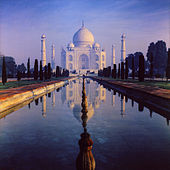Thawb
From Wikipedia, the free encyclopedia
 Part of a series on |
|
|---|---|
| Architecture | |
|
Arabic · Azeri |
|
| Art | |
|
Calligraphy · Miniature · Rugs |
|
| Dance | |
| Dress | |
|
Abaya · Agal · Boubou |
|
| Holidays | |
|
Ashura · Arba'een · al-Ghadeer |
|
| Literature | |
|
Arabic · Azeri · Bengali |
|
| Martial Arts | |
| Music | |
| Dastgah · Ghazal · Madih nabawi |
|
| Theatre | |
A thawb or thobe (Arabic: ثوب, ṯawb), dishdasha (دشداشة dišdāšah), kandura (كندورة kandūrah) khameez (قميص qamīṣ), or suriyah in Libya, is an ankle-length garment, usually with long sleeves, similar to a robe.
[edit] Background
The word thawb is the standard Arabic word for 'a garment'. It is the traditional Arab dress for men. It is sometimes spelled thobe or thaub. It is a tunic, generally long. The word is used specifically for this garment in the Persian Gulf States. There has been some debate regarding the correct length of the thawb.
The thawb is typically worn by men in the Arabian Peninsula, Egypt, Morocco, and other Muslim countries. It is normally made of cotton, but heavier materials such as sheep's wool can also be used, especially in colder seasons. The style of the thawb varies slightly among the various regions within the Persian Gulf. The sleeves and the collar can be stiffened to give a more formal appearance. Other names may be used for this garment. In Souraqia, dishdasha is the most common word for the garment. In Morocco, the sleeves tend to be much shorter so that the thawb may seem more like a long T-shirt and is locally called gandora. Also the neck tends to be more open than in its Saudi counterpart and is often embroidered as is the breast pocket. Also it might lack buttons altogether.
The term thawb is also used to refer to similar women's garments. The traditional Palestinian woman's long tunic is called thawb. Another example is a very long, over-sized woman's garment with a heavily embroidered front panel and billowing back, also known as a Khaleeji dress, which is most commonly seen in the West worn for performance of the Saudi women's social-style dances, in which manipulation of the large thawb is a key component.
[edit] See also
| This clothing-related article is a stub. You can help Wikipedia by expanding it. |

